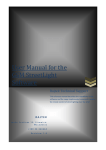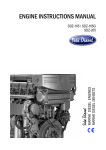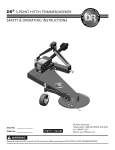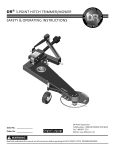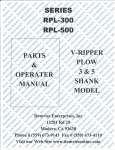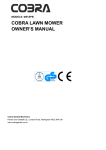Download ManualsLib - Makes it easy to find manuals online!
Transcript
AU WARRANTY INFORMATION ELECTRIC LAWN MOWER WARRANTY The benefits conferred by this warranty are in addition to all other conditions and warranties in respect of this product which the consumer may have taken under the Trade Practices Act 1974 or by any legislation of a State or Territory of Australia. This product is warranted by Talon Tools Australia (ABN 12 099 520 939)(the “Company”) to be free from defects in material and workmanship for a period of 24 months from the date of original purchase. The Company during the period of the warranty, will at its option, and subject to the conditions stated herein, repair or replace without charge this product or any component part, which upon examination by an Authorised Service Agent or by the Company is found to be defective. USER MANUAL Electric Rotary Lawn Mower Warranty conditions This warranty will not apply: (i) where this product has been subjected to misuse, abuse, accident or want of care; (ii) where this product has been used for a purpose for which it was not designed or is not suited; (iii) where the service of this product has been undertaken by a person not authorised by the Company to carry out such work or where parts that have not been approved by the Company have been used; (iv) where this product has been used for industrial or commercial purposes. SAFETY OPERATION MAINTENANCE Should service become necessary during the warranty period, the purchaser should contact an Authorised Service Agent or the Company. In order to obtain warranty service, the purchaser must present the store receipt showing the name of the retailer and the date of purchase together with a completed Warranty Card. The period of the warranty begins from the original date of purchase, notwithstanding any subsequent repair or parts replacement. No additional warranty or guarantee other than set out in this document, whether written or verbal, is authorised to be made on the Company's behalf. The purchaser shall be responsible for delivery or causing the product to be delivered to the Company or the Authorised Service Agent and the purchaser shall be responsible for all charges in connection with re-delivery of the product and/or the delivery of parts. Damage in transit is not covered by this warranty and purchasers should remove from the product any liquids (if applicable) before sending and pack the product securely to prevent damage. Warranty exclusions Normal wear parts or components are subject to separate terms as follows: Normal wear parts, components or service required when performing normal and regular maintenance of this product are not covered by warranty unless it is found to be defective by an Authorised Service Agent or by the Company. Normal wear parts include, but are not limited to: Cutting Blades. DOUBLE INSULATED Returns based on the above listed normal wear parts will not be accepted under this warranty as they are considered consumable items and are at the expense of the purchaser. WARNING • PLEASE READ For your own safety please read this manual before attempting to operate your new unit. Failure to follow instructions can result in serious personal injury. Spend a few moments to familiarize yourself with your mower before each use. MODEL NO. AM2053 6096-205301 1 AU GENERAL SAFETY RULES AU ADDITIONAL SAFETY INSTRUCTIONS The meaning of the symbols marked on this product are as follows Read the user manual before using the machine Watch out your hands when you replace the blade Whenever the machine is in use, safety goggles must be worn to safeguard against flying objects, as must ear protectors in order to protect hearing. Wear gloves to protect your hands Do not put hands or feet near or under rotating parts Do not use on slopes of more than 16.7Þ Never mow while people, especially children or pets are nearby Do not operate unit without proper attachments and guards in place Wear safety boots to protect against electric shock WARNING! When using electric lawn mowers, basic safety precautions, including the following, should always be followed to reduce the risk of fire, electric shock and personal injury. Read all these instructions before operating this product and retain these instructions for future reference. • Disconnect tools When not in use, before servicing and when changing accessories such as blades, bits and cutters. • Stay alert Watch what you are doing. Use common sense. Do not operate tool when you are tired. • Check damaged parts Before further use of the tool, a guard or other part that is damaged should be carefully checked to determine that it will operate properly and perform its intended function. Check for alignment of moving parts, free running of moving parts, breakage of parts, mounting and any other conditions that may affect its operation. A guard or other part that is damaged should be properly repaired or replaced by an Authorised Service Centre unless otherwise indicated in this instruction manual. Have defective switches replaced by an authorised service facility. Do not use the tool if the switch does not turn it on and off. • Residual Current Device (RCD) It is recommended that a Residual Current Device with a tripping current of not more than 30mA is used. • WARNING! The use of any accessory or attachment, other than those recommended in this instruction manual, may present a risk of personal injury. • Have your tool repaired by a qualified person This electric tool is manufactured in accordance with the relevant safety requirements. Repairs should only be carried out by qualified persons using original replacement parts, otherwise this may result in considerable danger to the user. • WARNING! This tool must not be used by anyone under 16 years of age. You have a responsibility of safety to others when you are operating this tool. • Before using, always visually inspect to see that the blades, blade bolts and cutter assembly are not worn or damaged. Replace worn or damaged blades and bolts in sets to preserve balance. • Keep work area clean • Consider work area environment Do not expose power tools to rain. Do not use power tools in damp or wet locations. Keep work area well lit. Do not use power tools where there is risk of fire or explosion. • Keep children away Do not let children touch the tool or extension cord. All bystanders should be kept away from area. • Store idle tools When not in use, tools should be stored in a dry, high or locked up place, out of reach of children. • Do not force the tool It will do the job better and safer at the rate for which it was intended. • Dress properly Do not wear loose clothing or jewellery, they can be caught in moving parts. Work gloves and non-skid footwear are recommended when working outdoors. Wear protective hair covering to contain long hair. • Use safety glasses Also use face or dust mask if the cutting operation is dusty. • Do not abuse the cord Never carry the tool by the cord or yank it to disconnect it from the socket. Keep the cord away from heat, oil and sharp edges. • Do not overreach Keep proper footing and balance at all times. • Maintain tools with care Keep cutting tools sharp and clean for better and safer performance. Follow instructions for lubrication and changing accessories. Inspect tool cord periodically and if damaged have it repaired by an authorised service centre. Inspect extension cords periodically and replace if damaged. Keep handles dry, clean and free from oil and grease. 2 13. If the equipment should start to vibrate abnormally release switch lever and unplug the mower and check immediately for the cause. Vibration is generally a warning of trouble. 14. Release switch lever to turn mower off, wait for the blade to stop and unplug the mower whenever you leave the equipment, before unclogging the deck or chute, or cleaning the mower housing, and when making any repairs or inspections. 15. When cleaning, repairing, or inspecting, make certain the blade and all moving parts have stopped. 16. Shut the motor off and wait until the blade comes to a complete stop, then disconnect the power cord before removing the grass catcher or unclogging the chute. 17. Mow across the face of slopes; never up and down. Exercise extreme caution when changing direction on slopes. Do not mow excessively steep slopes. 18. Never operate the mower without proper guards, plates, or other safety protective devices in place. 19. If an extension cord is used make sure it is for outdoor use and marked as such. The recommended size of extension cord is not lighter than 1.5mm2 and a maximum of 10 metres in length. 20. Completely uncoil your extension cable before use to prevent overheating and loss of mower efficiency. When tidying away the cable, wind it carefully to avoid kinking. 21. If power cord is damaged, only have it repaired or replaced by an authorised service centre. 22. Always stop the mower and switch off at the mains when cutting is delayed, emptying the grass box or when walking from one cutting location to another. 1. Read this instruction manual carefully. Be thoroughly familiar with the controls and the proper use of the equipment. 2. Never allow children to operate a power mower. 3. Keep the area of operation clear of all persons, particularly small children, and pets. 4. Thoroughly inspect the area where the equipment is to be used and remove all stones, sticks, wires, bones, and other foreign objects that could be thrown by the blade. 5. Do not operate the equipment when barefoot or wearing open sandals. Always wear substantial footwear. 6. Never attempt to make a wheel height adjustment while the motor is running or while the mower is plugged in. 7. Mow only in daylight or in good artificial light. 8. Never operate the equipment in wet grass. Always be sure of your footing; keep a firm hold on the handle and walk; use extreme caution. Look where you are walking. 9. Do not put hands or feet near or under rotating parts. Keep clear of the discharge opening at all times. 10. Release switch lever to turn mower off when crossing gravel drives, walks, or roads. 11. If the mower stalls, be sure to release switch lever to turn mower off, wait for the blade to stop and unplug the cord before attempting to unclog the chute or remove anything from under the deck. 12. After striking a foreign object, release switch lever to turn mower off, wait for the blade to stop and unplug the mower, thoroughly inspect the mower for any damage, and repair the damage before restarting and operating the mower. SPECIFICATIONS Rated Power . . . . . . . . . . . . . . . . . . . . . . . . . . . . . . . . . . . . . . . . . . . . . . .1500W No Load Speed . . . . . . . . . . . . . . . . . . . . . . . . . . . . . . . . . . . . . . . . . . . . .3500-4000/min Blade Width . . . . . . . . . . . . . . . . . . . . . . . . . . . . . . . . . . . . . . . . . . . . . . . .34cm Height of Cut . . . . . . . . . . . . . . . . . . . . . . . . . . . . . . . . . . . . . . . . . . . . . . .20-70mm Catcher Capacity . . . . . . . . . . . . . . . . . . . . . . . . . . . . . . . . . . . . . . . . . . . .40 Litres Net Weight . . . . . . . . . . . . . . . . . . . . . . . . . . . . . . . . . . . . . . . . . . . . . . . . .16 kg Sound pressure level . . . . . . . . . . . . . . . . . . . . . . . . . . . . . . . . . . . . . . . . .76 dB(A) Sound power level . . . . . . . . . . . . . . . . . . . . . . . . . . . . . . . . . . . . . . . . . . .96 dB(A) Vibration . . . . . . . . . . . . . . . . . . . . . . . . . . . . . . . . . . . . . . . . . . . . . . . . . . .< 2.5 m/s2 3 AU AU ASSEMBLY INSTRUCTIONS GENERAL INFORMATION 3 ASSEMBLY 1. To assemble the handle, straighten the upper handle and tighten to lower handle with locking knobs. (Fig. 1A) Insert the ends of the handle into the holes located on either side of the mower housing (Fig. 1B) To fasten handle to mower insert the two locking screws into the holes (A) located at the back of either side of the mower. (Fig. 1C) To attach the catcher, open the rear catcher door and insert the catcher into the mower. Release catcher door to lock catcher in place. (Fig. 1D) 1 2. 4 A • 3. 2 4. B Fig. 3 6 Bolt 11 Locking Knobs 8 Bolt Fig. 1A Fig. 1B 7 A Fig. 1C 1. Start Lever 7. Catcher 2. Power Cord 8. Top Cover 3. Safety Switch 9. Height Lever 4. Upper Handle 10. Wheels • LAWN MOWER HEIGHT ADJUSTMENT 1. Before making any height adjustments, release start lever and B safety switch to turn mower off, wait for blade to stop rotating, A and then unplug mower from power C mains. To raise or lower cutting Fig. 2 heights, pull the height lever (A) upwards and push down on the mower (B) to decrease the cutting height or push up to raise the cutting height. The cutting height indicator (C) will move indicating the cutting height of the mower. (Fig. 2) 5. Lower Handle 11. Catcher Space Indicator 6. Locking Knobs 2. • HOW TO START 1. Before starting the machine adjust the lawn mower to the cutting height you need. (Refer to section on Lawn Mower Height Adjustment) Your lawn mower is equipped with a special safety switch (A). To operate the switch, depress the safety switch (A) then grasp the start lever (B) to start running. (Fig. 3) 2. 4 MOWING PROCEDURE 1. When the grass indicator (A) on the catcher is raised it means the catcher is full. (Fig. 4A) 2. Open the rear catcher door (B). (Fig. 4B) 3. Lift and remove catcher. (Fig. 4C) Fig. 1D OPERATING INSTRUCTIONS 9 • • EMPTYING THE CATCHER A 10 The power will be off when the start lever is released. To restart the mower repeat step 2. The key to successful electric lawn mowing is a systematic approach to cutting. Take a few moments to plan your first cut using the principles described herein. After one or two uses you will find the easiest way of cutting your own lawn. 1. Lay cord on ground near outlet in neat, loose coils. It is important to arrange cord systematically to avoid annoying loops and knots. 2. Starting at point nearest electrical outlet, move back and forth across lawn. 3. Each lawn is different and may have trees, shrubs, and other obstructions that may require a different mowing procedure. A little experimenting will enable you to choose the easiest method of handling the cord on your lawn. Handle 5 3. A Fig. 4A B Fig. 4B Fig. 4C • TO GET THE MOST FROM YOUR POWER MOWER AND YOUR LAWN • • 5 Lawn should first be mowed in the spring when the grass is about 2-1/2” to 3” (6.4cm to 7.6cm) high. Mowing too early restricts the grass root systems which renew themselves every spring. New grass should be clipped lightly when it is about 2-1/2” (6.4cm). Mow your lawn when it is dry, to avoid clumping of wet grass. If you have a choice, late afternoon is the ideal time for mowing, not only because the grass is dry, but also because the sensitive new cut area of the grass will not be exposed to direct sun light. AU MAINTENANCE INSTRUCTIONS • Do not cut more than 1/3 of the grass height during each cutting. Cutting too close “shocks” sensitive grass blades, resulting in a shallow root system and thus making it more difficult for your lawn to reach water in the soil. Lawn care experts say continued, excessively close cutting is responsible for much of the difficulty experienced on many lawns. The depth and strength of the roots of grass are almost exactly proportional to its top growth. Grasses of mature lawns often are seriously injured when mowed shorter than 1-1/2” (3.8cm), and a height of 1-1/2” to 2” (3.8cm to 5.1cm) is preferred on large lawns. • Keep the mowing blade sharp for a nice clean cut. A dull blade shatters the grass, impairing the healthy growth of your lawn and increasing leaf susceptibility to turf diseases. A dull blade bruises the tips of the grass and causes a brownish appearance. It may also pull up young seedlings. • Keep the underside of the mower clean. • While there are times when you should vary the cutting height (with the changing seasons), as a general rule try to mow your lawn at the same (consistent) cutting height even if you have to mow more frequently during periods of fast growth. A healthier, lovelier lawn with generally fewer weeds will be your reward. Frequent cutting ensures that the lower, less attractive part of the grass will not show. • If your lawn has grown too long (a vacation, for example, may interrupt your cutting schedule), mow at a cutting height one or two positions higher-than-normal; a second pass at “normal” cutting height a few days later will put your lawn back on schedule. • And finally, three good ideas to enhance your lawn’s appearance: vary the mowing direction frequently; mow horizontally on hillsides, (this is also a good safety practice) and don’t forget to overlap the mowing path on each pass. • REMOVING AND ATTACHING BLADES 1. 2. RELEASE STARTING LEVER AND SAFETTY SWITCH TO TURN MOWER OFF AND UNPLUG MOWER FROM POWER MAINS! Wear gloves. Using a wrench, unscrew the bolt by turning it in a counter clockwise direction as shown in Fig. 5. Grasp the blade with the other hand to prevent it turning. Remove the bolt , spring washer, plain washer and blade (Fig. 6) Blade Motor Shaft Plain washer Spring Washer Bolt WARNING: • • • • • • The least dangerous method for mowing on hills and terraces is along the side (horizontally) instead of up and down. This will place you away from the mower if you slip. It will also reduce scalping on crowns of hills. Exercise extreme caution to avoid slipping and contacting the rotating blade, while mowing on hills. Because of the increased danger of slipping (even on level surfaces), never mow when grass is wet or damp. Use extreme caution when reversing or pulling the appliance towards you. Stop the blade(s) if the appliance has to be tilted for transportation. Switch on the motor according to instructions and with feet well away from the blades (s.) Never pick up or carry an appliance while the motor is running. Do not tilt mower when switching on the motor, except if the appliance has to be tilted for starting. In this case, do not tilt it more than absolutely necessary and lift only the part which is away from the operator. Always ensure that both hands are in the operating position before returning the appliance to the ground. 5. • BLADE SHARPENING WARNING: Keep the blade sharp for best mower performance. 1. RELEASE STARTING LEVER AND SAFETY SWITCH TO TURN MOWER OFF, WAIT UNTIL BLADE STOPS AND UNPLUG MOWER FROM POWER MAINS! 2. The blade can be sharpened in several different ways. Try to maintain the original cutting angle, and sharpen each cutting edge an equal amount. (Fig. 8) • • • • Fig. 6 Wear gloves, when fitting a blade. Make sure cutting edges of the blades are closest to ground. Align the flats on the motor shaft with those in the hole on the centre of the blade. Fit the blade to the motor shaft Insert the bolt, with the plain and spring washers as shown in Fig. 6, with one hand grasp the blade to prevent turning and then securely tighten the bolt by turning it in a clockwise direction using a wrench. PROBLEM CHECK LIST BY HAND - Blade need not be removed. Being careful not to cut yourself, sharpen both edges of the blade with a sharpening stone or fine tooth file. Always replace a bent or damaged blade to prevent excessive vibration from damaging your mower. The blade is sharpened and balanced before it leaves the factory. However, after several home sharpening and repeated impact from striking solid objects your blade may become unbalanced. An unbalanced blade causes vibration which could damage the motor drive unit. Any professional service Depot can provide a new blade at reasonable cost. • OTHER SHARPENING METHODS Wear proper eye protection! With the blade removed from the mower, it can also be sharpened on a bench grinder. • BLADE BALANCING When sharpening a blade using a file or grinder, sharpen only the leading edge (See Fig. 9A) Check balance of blade by placing centre hole in blade over a nail or screwdriver shank, clamped horizontally in a vice. If either end of the blade rotates downward, grind or file that end. Blade is properly balanced when neither end drops. See Fig. 9B Fig. 9A Fig. 9B Fig. 7 6 Keep all nuts, bolts, and screws tight to be sure the appliance is in safe working condition. Check the grass catcher frequently for wear or deterioration. Replace worn or damaged parts for safety. Stop the blade(s) if the appliance has to be tilted for transportation. Your mower has been designed and built to provide you with trouble-free operation. If problems do occur check the following: 1. Failure to start a) Ensure cord connection to extension is tight. b) Make sure unit is plugged in at wall outlet. c) Check circuit breaker either at plug or on panel. d) If the mower will still not operate return it to the nearest Talon authorised warranty repair agent for repairs. Under no circumstances should you attempt to solve the electrical problem yourself. 2. Tripping of circuit breaker. 3. Vibration If excess vibration is present, release switch lever, unplug the cord and turn unit over to check the blade. a) Ensure blade is secured tightly to the motor shaft. If the blade appears loose check that the flats in the hole in the centre of the blade align securely with the flats on the motor shaft. If there is excessive play in this area it may be necessary to replace the blade. Wear in this area can be the result of the blade not having been securely tightened. b) Check blade for gouging or nicks. Remove and check balance. See Fig. 9B. Re-sharpen blade if necessary. If blade is bent discontinue use and replace with identical replacement blade. If unit continues to vibrate return it to your nearest professional service depot for repair. 4. Uneven cut a) Check to ensure blade is sharp. Fig. 8 Fig. 5 3. AU 7





